Physical Address
304 North Cardinal St.
Dorchester Center, MA 02124
In this chapter, we will discuss some additional applications of ultrasound (US), including vascular ultrasound, pediatric applications of ultrasound, and point-of-care ultrasound.

This is a sagittal US image of the chest/right upper quadrant in a 75-year-old who had increasing shortness of breath from congestive heart failure. What complication of that disease is depicted on the image? The answer is at the end of this chapter. Ant, Anterior; F, foot; H, head; L, liver; Post, posterior.
Vascular US uses both B-mode (gray-scale) US and Doppler ultrasonography — a combination called duplex sonography —to display the morphologic appearance of vessels while recording the flow direction and velocity of moving blood in those vessels.
Duplex sonography ensures that the direction and flow measurements are made in the exact anatomic location of interest ( ).
The two most common types of Doppler US are color Doppler and spectral Doppler.
Color Doppler can provide specific, but limited, information over a relatively large region, whereas spectral Doppler provides more precise information about a smaller region. The two modes are complementary.
Color Doppler US superimposes color on the gray-scale image to indicate the presence and direction of moving blood. By convention, red indicates movement toward the transducer and blue indicates movement away from transducer ( Fig. 19.1 ) .
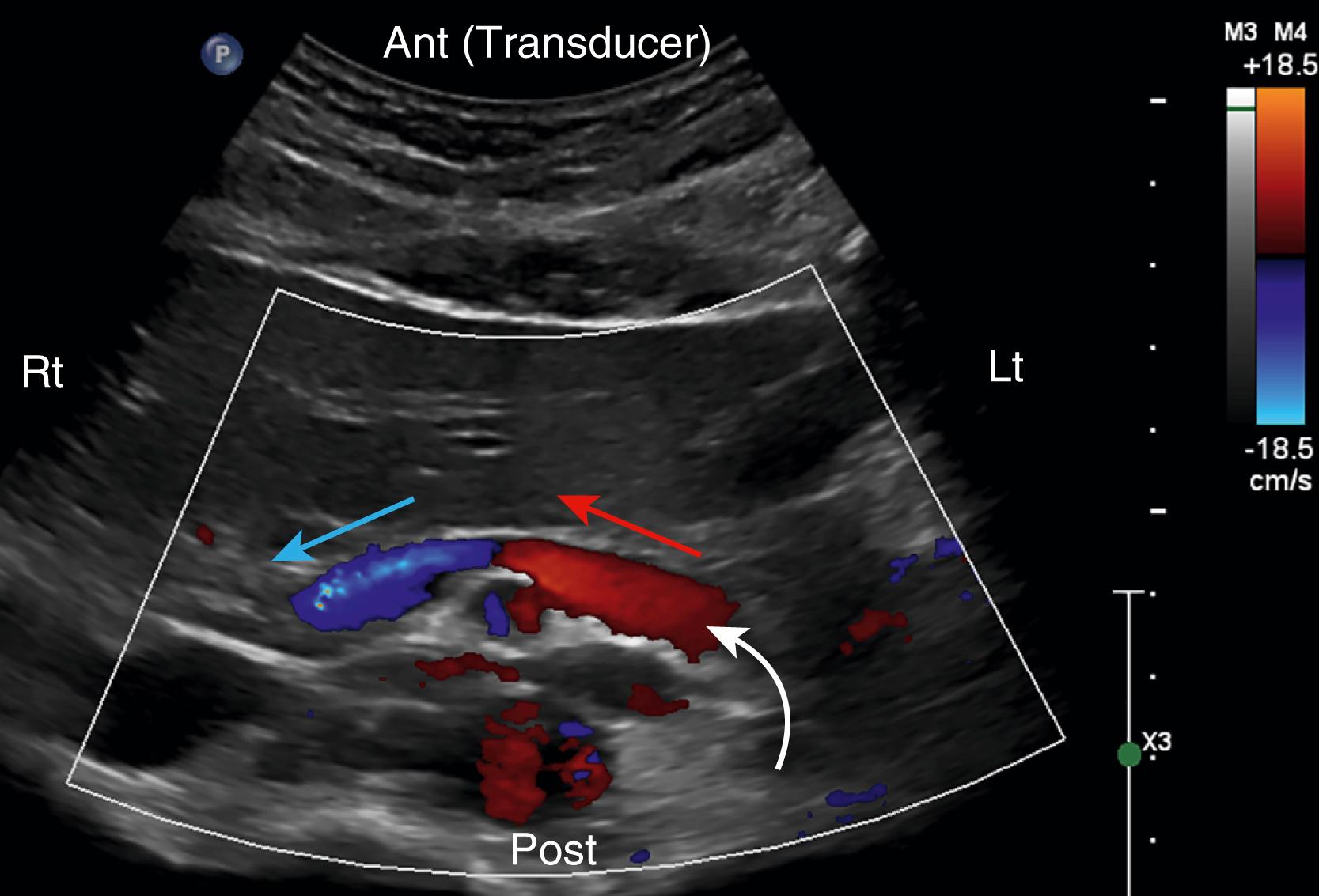
Spectral Doppler ultrasound is displayed as a waveform, which is a graphic representation of the velocity of flow measured over time within a focused area. It is depicted along an X (time) and Y (velocity) axis. By convention, flow toward the transducer is displayed above the baseline and flow away is below the baseline ( Fig. 19.2 ) .
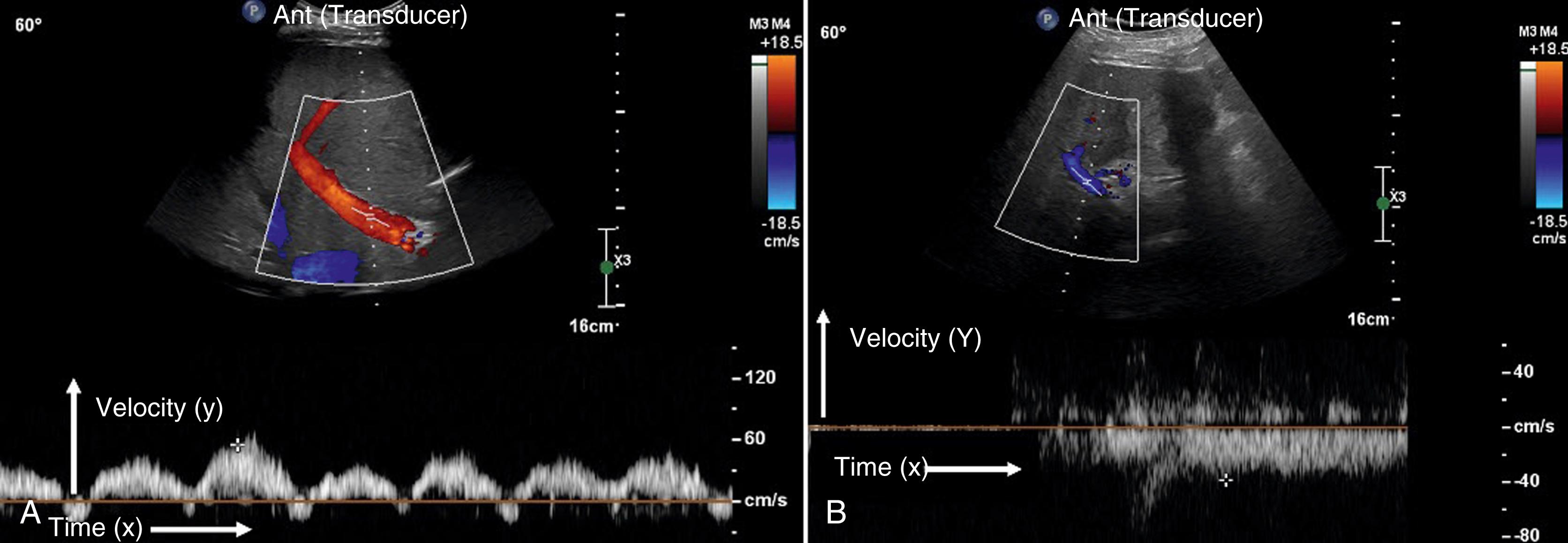
There are distinctive arterial spectral Doppler waveforms, depending on the resistance to blood flow in the vascular bed that the artery supplies ( Figs. 19.3 and 19.4 ). Venous waveforms can also vary depending on their proximity to the heart, the cardiac function, and phase of respiration.
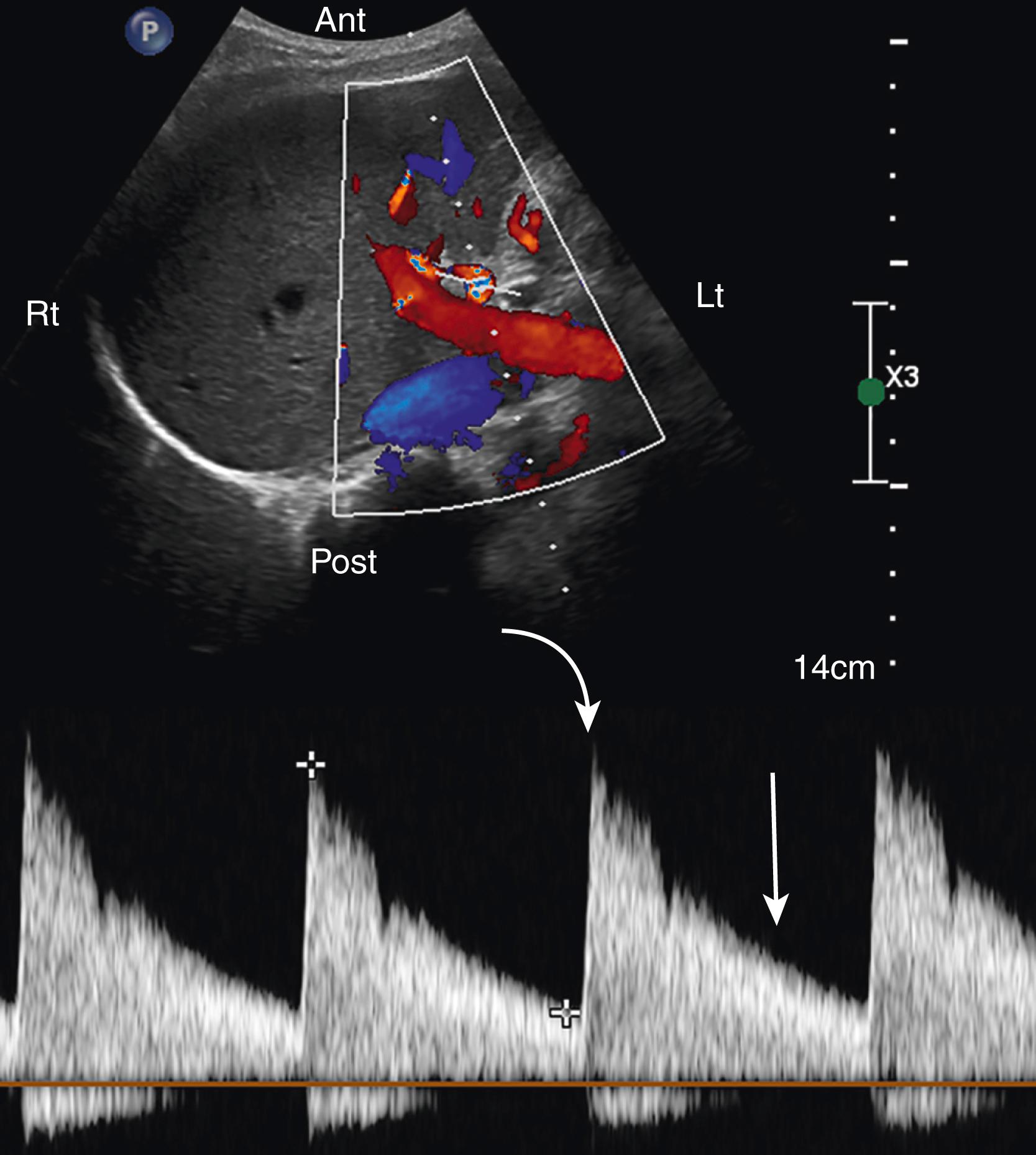
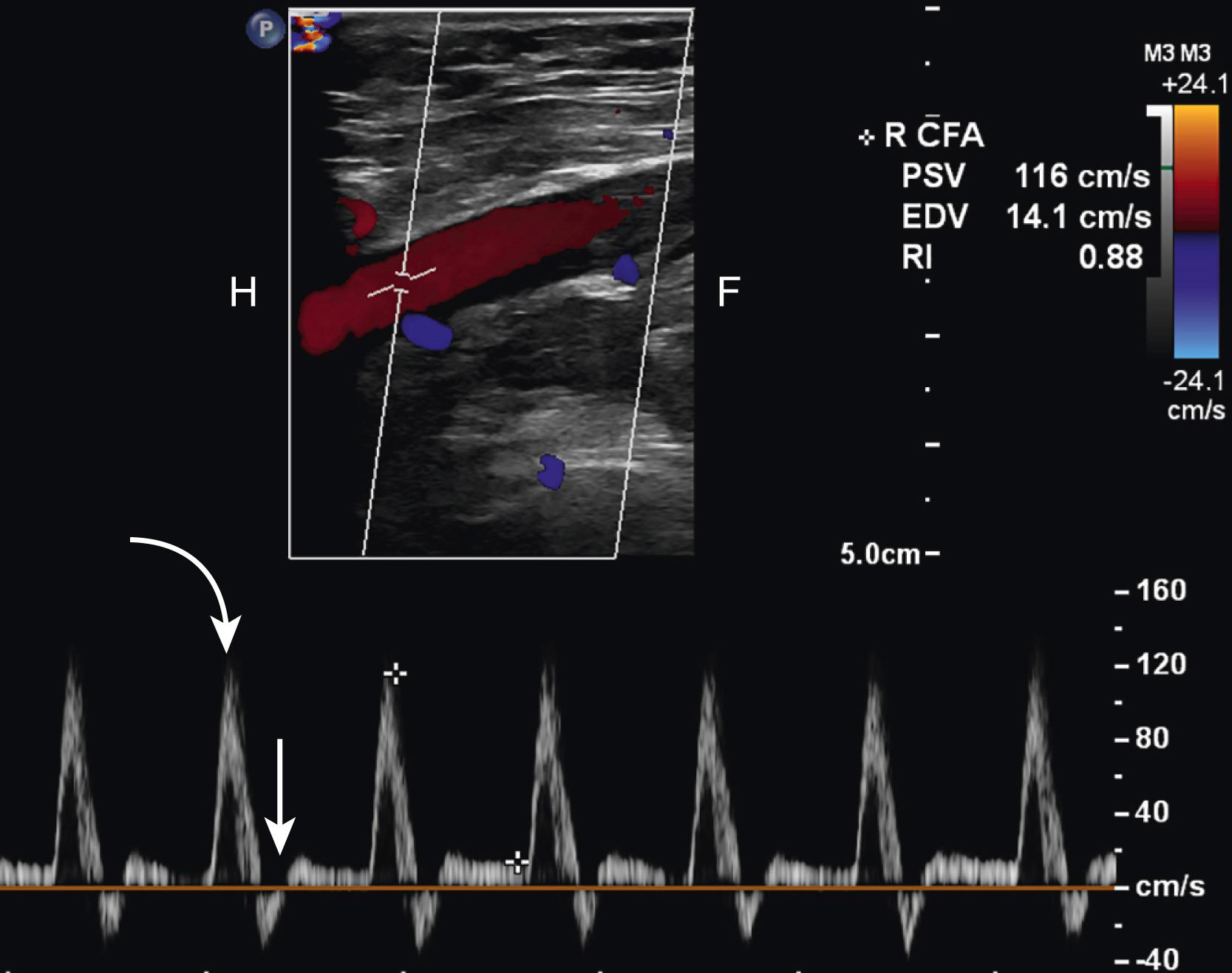
If a US signal is reflected from a stationary object , the returning signal should theoretically retain the same frequency with which it was transmitted. But based on the principles of Doppler US, the frequency of a signal reflected from moving objects , such as blood cells, will change in proportion to the velocity of the target.
With this information, we can interrogate (i.e., systematically examine) vessels to determine whether they are narrowed or occluded because an arterial stenosis leads to an increase in blood velocity through the area of narrowing. If we gradually advance the Doppler probe along the path of a blood vessel, we can identify a stenotic lesion and its location.
This is analogous to the velocity of water flowing through the open end of a garden hose. When the opening of the garden hose is narrowed, the velocity of the flowing water must increase for the same volume of water to flow through the smaller lumen ( Fig. 19.5 ).
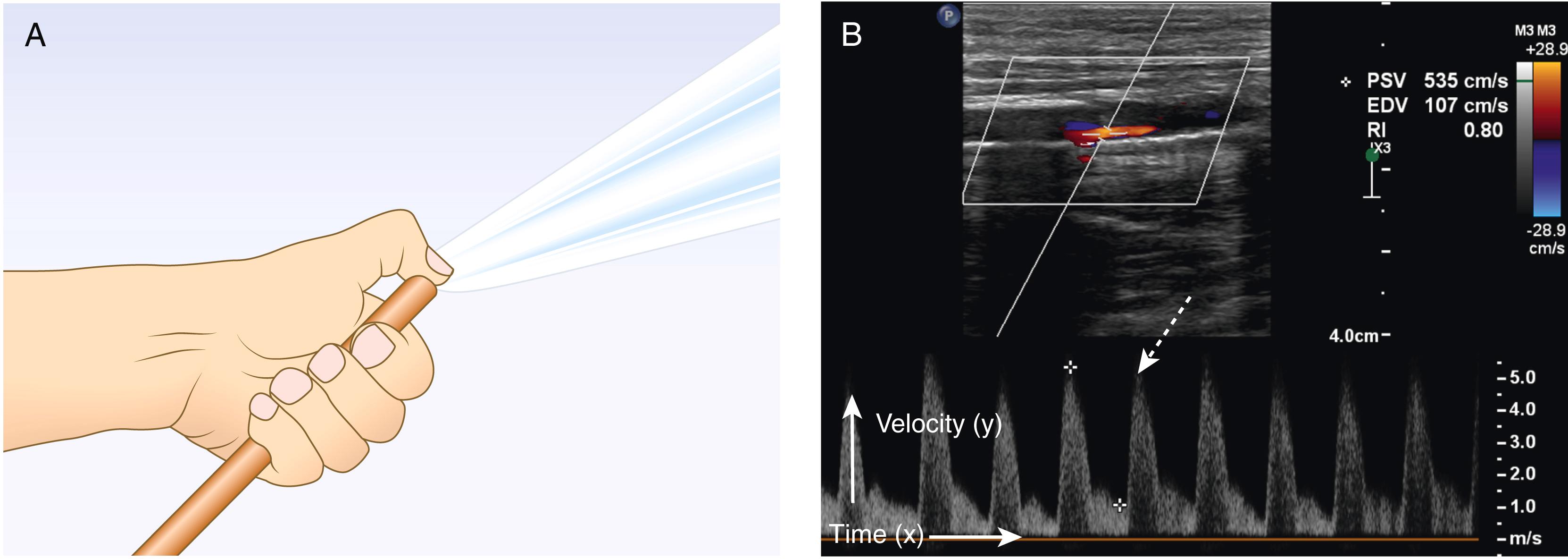
Because of changes in blood flow, abnormalities in the spectral waveforms can also suggest narrowing or occlusion that occurs in a part of the vessel that is more proximal or distal to the area being studied.
Carotid ultrasonography has become the study of choice for the noninvasive assessment of extracranial atherosclerotic disease. Carotid US is also used to evaluate bruits, as preoperative screening prior to other major vascular surgery, and to assess the patency of the vessel after endarterectomy.
When there is greater than 50% stenosis of the carotid artery lumen, the velocity of flow becomes elevated. Significant stenosis alters the Doppler waveform at points proximal , at , and distal to the stenosis.
Ultrasound is also used to assess the thickness of the vessel wall (it gets thicker with atherosclerosis) and the presence and nature of plaque.
Peripheral artery disease occurs when atherosclerotic plaques are deposited in the arteries feeding the extremities. Significant narrowing or occlusion of the peripheral arteries usually occurs in the lower extremities and can result in claudication (i.e., leg pain during exertion) or pain at rest.
Risk factors include smoking, diabetes, hypertension, hyperlipidemia, male gender, and Black ethnicity.
The peripheral arteries in the extremities normally have what is called a high-resistance waveform because at rest , the vascular bed in the muscles they supply is constricted (see Fig. 19.4 ).
Significant narrowing of a peripheral artery will cause an elevation in the velocities of the flowing blood.
Blood pressures are measured by detecting arterial flow with a Doppler probe on the artery instead of with a stethoscope. Pressures are usually taken in both arms and the posterior tibial and dorsalis pedis arteries in each leg by inflating blood pressure cuffs past the point where flow and Doppler sounds cease , then slowly deflating the cuffs until flow and Doppler sounds return.
Normally, the systolic blood pressures in the ankle should be equal to that in the arm resulting in an ABI of 1. As the blood pressure in the ankle falls due to peripheral vascular disease in the legs and because ankle pressures are the numerator for the ABI, there will be a decrease in the value of the ABI, and an ABI of 0.5 or less usually indicates severe arterial disease.
One of the complications following an invasive vascular procedure, such as cardiac catheterization, is the development of a pseudoaneurysm, most often at the catheter entrance site. This is usually in the groin at the common femoral artery or in the arm at the brachial artery.
A pseudoaneurysm forms when there is a rupture or injury to the arterial wall , but the blood leaking through the defect remains confined either by an intact, thin outer layer of the arterial wall itself or by the surrounding perivascular tissues. Because the wall or perivascular tissue containing the pseudoaneurysm is very thin, it is at high risk for further rupture and extravasation. In contradistinction, a true aneurysm’s arterial walls are intact but the caliber of the artery is abnormally dilated.
On US, a pseudoaneurysm appears as a hypoechoic outpouching arising from an artery ( ). Occasionally, the pseudoaneurysm may be connected to the artery by a thin neck or stalk. Blood flowing into and out of a pseudoaneurysm results in a distinctive appearance on color and spectral Doppler images ( Fig. 19.6 ).
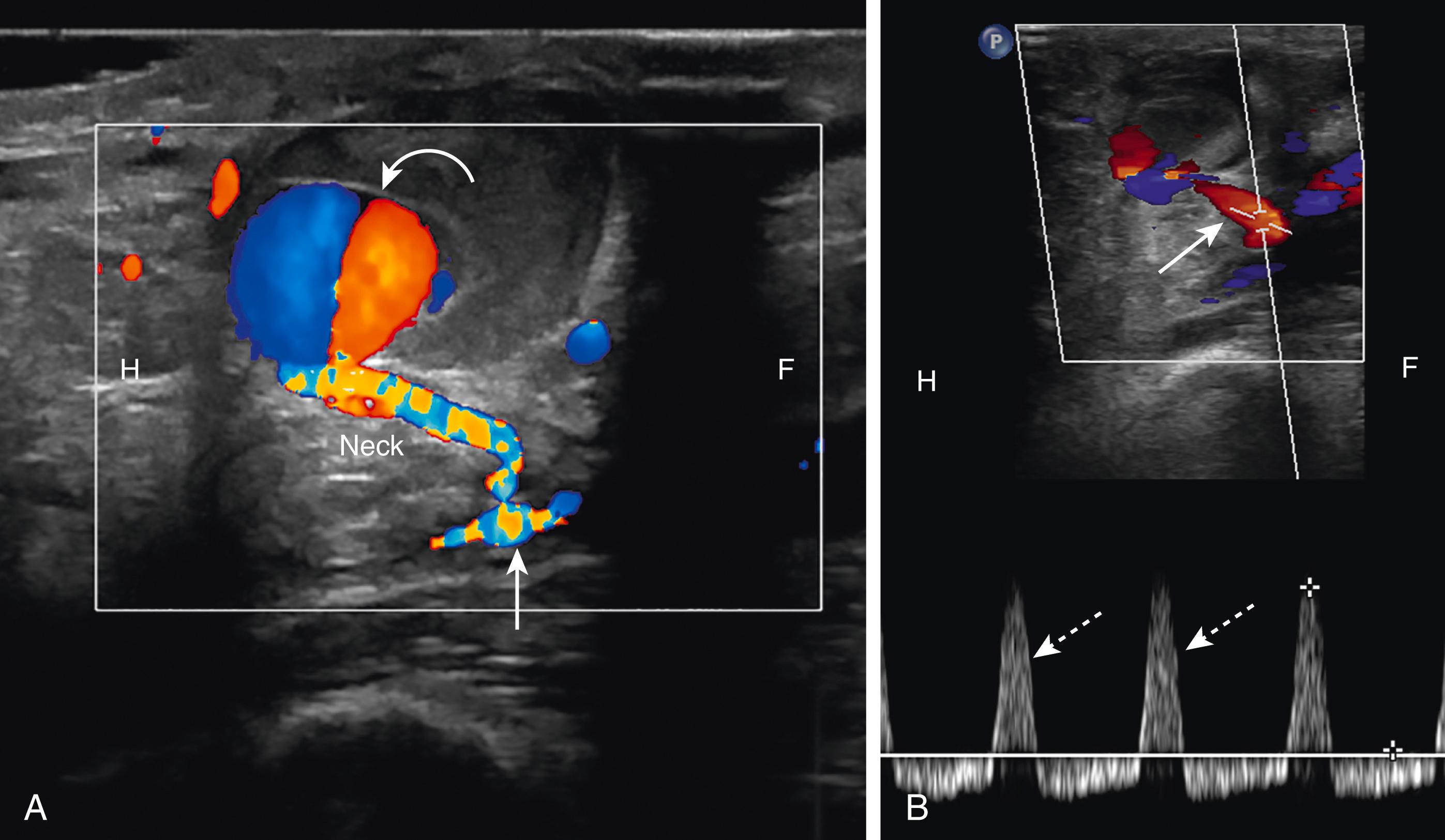
Ultrasound is also used for the treatment of pseudoaneurysms by applying direct compression with the US probe to occlude the aneurysm sac, especially if the sac is small. Ultrasound can also be used to guide thrombin injection resulting in thrombosis or occlusion of the pseudoaneurysm.
Ultrasound is the study of choice when deep vein thrombosis is suspected in the upper or lower extremities. Local symptoms can include pain, tenderness, and warmth in the affected area, although most patients with DVT are asymptomatic. The most serious complication of DVT is pulmonary embolism.
The highest-yield sonographic examination for DVT in the leg occurs in the symptomatic patient who manifests local symptoms above the knee. Ultrasound has a much lower sensitivity in asymptomatic patients.
Sonographic evaluation of deep venous thrombosis is usually performed in the legs but can also evaluate the arms. In the leg, it involves the use of the transducer to systematically compress the deep veins while scanning along certain anatomic landmarks, including the common femoral vein, proximal deep femoral vein, greater saphenous vein, femoral vein, popliteal vein, and the posterior tibial and peroneal veins. Similarly, DVT evaluation of the arms includes the internal jugular, subclavian, axillary, and brachial veins.
Normal venous structures have elastic walls and will easily compress and completely collapse when pressure is applied by the transducer. Veins containing thrombus will not completely collapse. The echogenic thrombus itself may be visualized on gray-scale imaging. Duplex sonography can also be used to determine the presence or absence of flow in the vein ( Fig. 19.7 ).
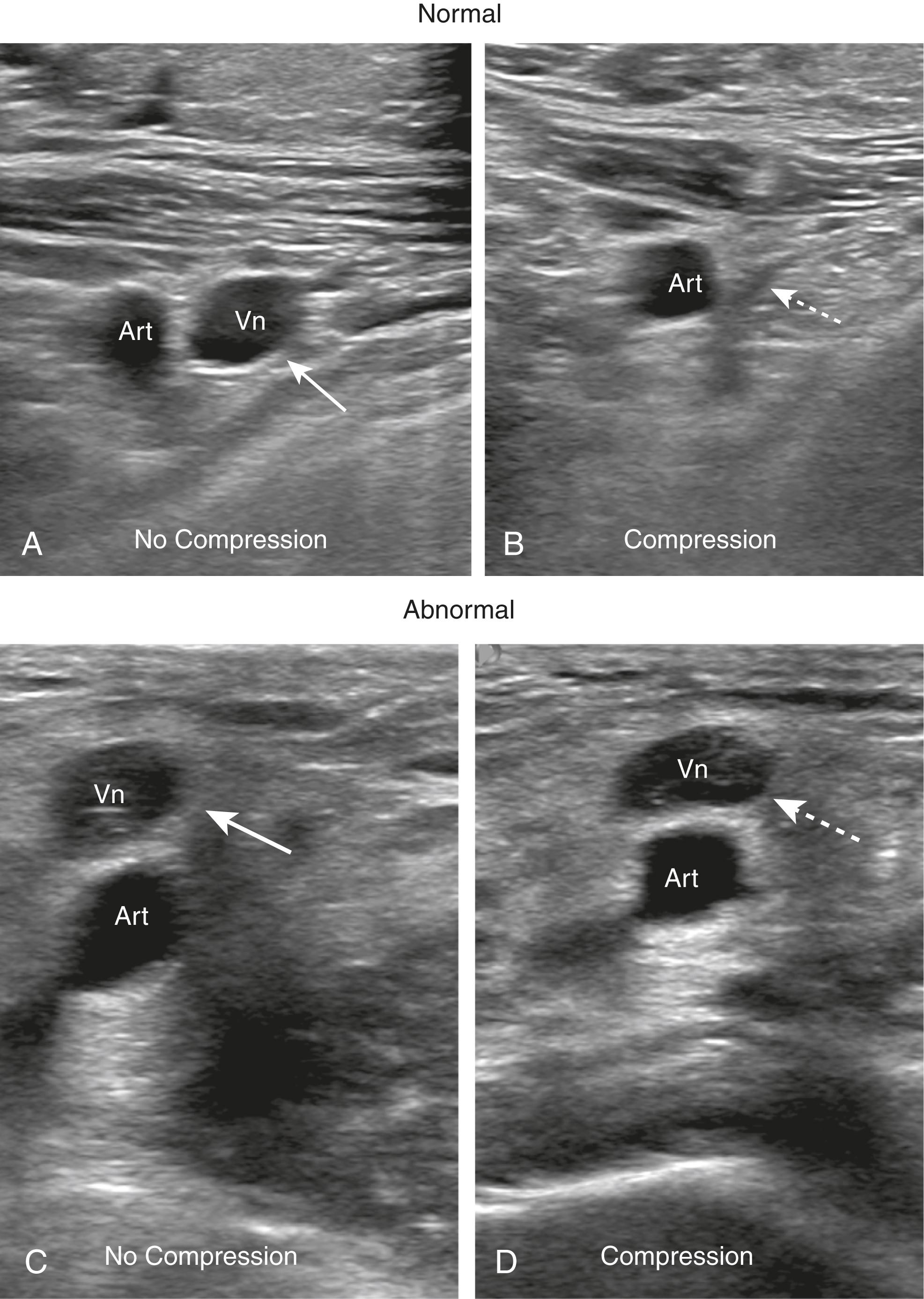
Become a Clinical Tree membership for Full access and enjoy Unlimited articles
If you are a member. Log in here